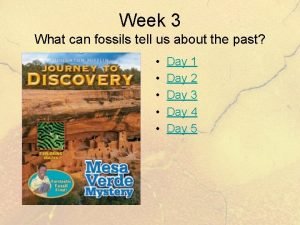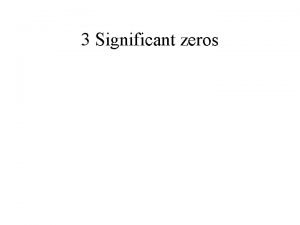Deeper and Deeper How can we tell the










- Slides: 10

Deeper, and Deeper How can we tell the age of the earth? What do rocks tell us about life on earth and the earth itself?

Which clothes were placed first? Which clothes were placed last?

A more accurate reflection of the clothes in your rooms

• Different rocks will form layers over time • This follows the Law of Superposition (superposition = placed above) • Lower layers were set down first. Upper layers were laid down on top of those below.

Different rocks form in different ways under different environmental conditions: <---- Limestone: Formed from skeletal fragments of marine animals such as coral, forams, and molluscs <----- Sandstone: Formed from breaking down of larger rocks in desert environments or near oceans, rivers, deltas, etc. <----- Shale (mudstone): Formed from compacted mud in lakes, lagoons, or river floodplains

• Over time different animals live in the environments that form the layers • When they die, they became buried in the ground • Just like the layers themselves, the deeper the animal, the longer ago it lived

Fossils • Most animal remains decompose and disappear • With the right conditions, an animals remains will become preserved in the rock

FIVE MAIN TYPES OF FOSSILS Petrified Fossils Molds and Casts Trace Fossils Carbon Films Preserved Remains

• Fossils become our snapshot of how animals have changed in the past • Without this record, we would know little about past animals • However, the fossil record is imperfect: • Most animals don’t fossilize: Less than “ 1 in a million” become fossils. • Only certain environments fossilize: Usually with nearby water like oceans, rivers, and deltas, or sudden volcanic eruptions • Fossils are difficult to find: Most fossils are deep underground and need plate tectonics to bring them to the surface over millions of years

Age of the Earth So, how old is the Earth? • According to the oldest fossils—stromatolites found in Western Australia—the earth must be at least 3. 48 billon years old. • Scientists argue that the Earth is actually 4. 6 billion years old from dating meteorites and moon rocks that have not been effected by plate tectonics but formed at the same time as the Earth.
 Into the heart of jesus deeper and deeper i go
Into the heart of jesus deeper and deeper i go You can tell harris about it just ____(easily) as i can.
You can tell harris about it just ____(easily) as i can. You can tell harris about it just ____(easily) as i can
You can tell harris about it just ____(easily) as i can Positive comparative superlative
Positive comparative superlative Tell me what you eat and i shall tell you what you are
Tell me what you eat and i shall tell you what you are Show don't tell generator
Show don't tell generator What can fossils tell us
What can fossils tell us Could you please tell me where is my uncle's room
Could you please tell me where is my uncle's room Tell me what you really like
Tell me what you really like How can you tell whether zeros are significant
How can you tell whether zeros are significant Could you tell me? where is the bookstore
Could you tell me? where is the bookstore



















